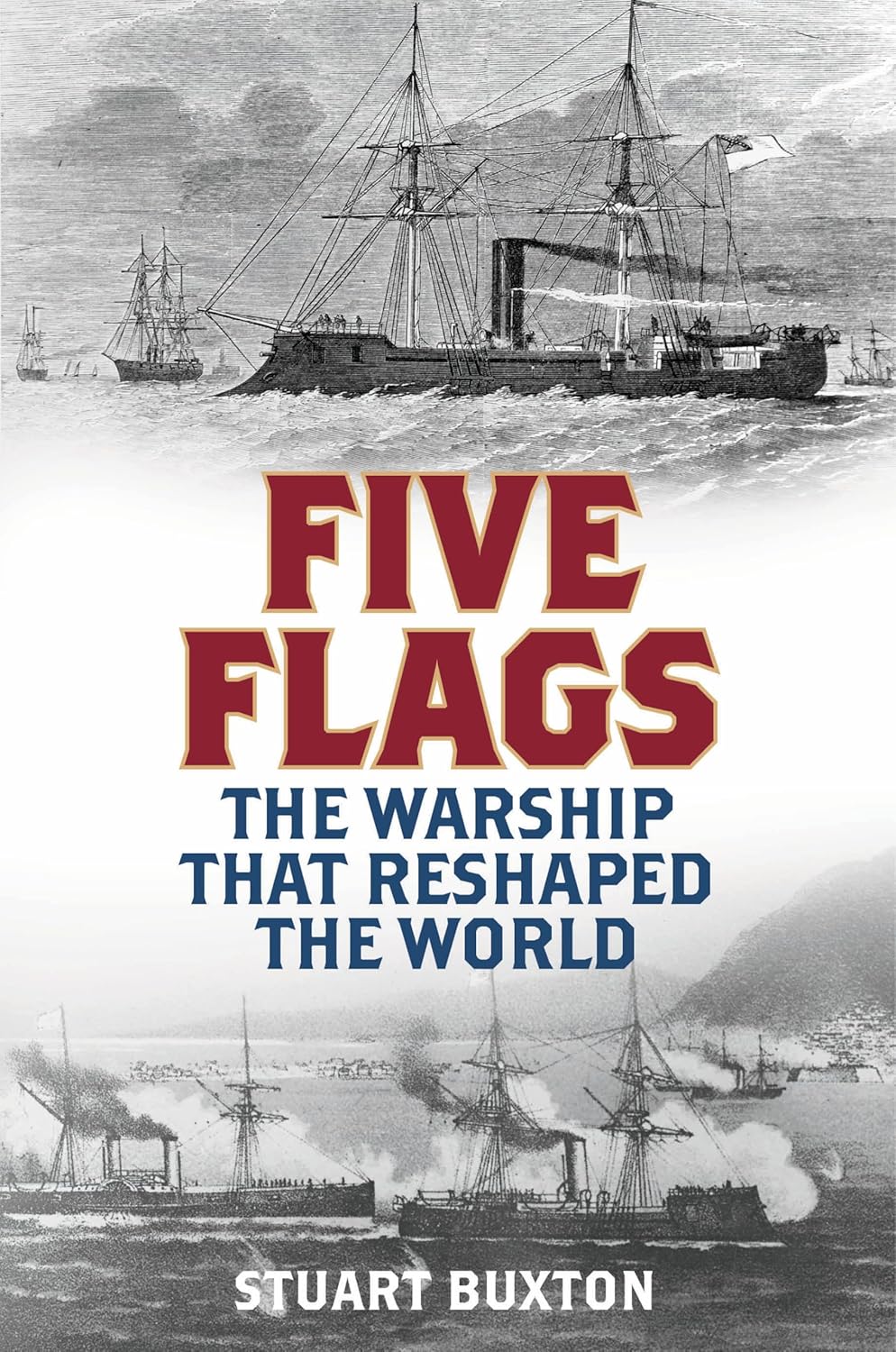Book Review: Five Flags: The Warship that Reshaped the World

 Five Flags: The Warship that Reshaped the World. By Stuart Buxton. Essex, CT: Stackpole Books, 2025. Hardcover, 348 pp. $34.95.
Five Flags: The Warship that Reshaped the World. By Stuart Buxton. Essex, CT: Stackpole Books, 2025. Hardcover, 348 pp. $34.95.
Reviewed by Neil P. Chatelain
I was extremely excited upon first hearing Stuart Buxton’s book was being published about the vessel most Americans know as the Confederate ironclad Stonewall. Built in France, the ship spanned active and inactive service for Denmark, the Confederacy, Spain, the United States, and Japan – and took part in civil wars of both the United States and Japan in the process. The ship’s clandestine construction, diplomatic plotting, and global reach makes this ironclad most worthy of a standalone book. However, Stuart Buxton’s Five Flags, the first real full book-length treatment on the ironclad, contains numerous shortcomings preventing it from reaching its full potential.
Buxton’s work is divided into two major parts. First are chapters focusing on the Confederacy, its construction of Stonewall in France, the ship’s sale to Denmark because of international complications, its ultimate repurchase by Confederates, and the ironclad’s transatlantic journey that culminated in its May 1865 surrender in Havana. The book’s second part focuses on the Tokugawa Shogunate purchasing the ironclad from the United States, how diplomatic and international pressure instead had the ironclad, renamed K?tetsu, instead serve Emperor Meiji, the ironclad’s participation in the Boshin War, and its subsequent Japanese service.
Buxton, who lives in Australia and worked in product management for decades in Asia, has a clearly organized book. Readers will easily follow the ship’s development, deployment, movement, and jurisdictional shifts, though there are occasional chapters inserted that do not follow the ship, but set the international stage.
For an ironclad with multiple names flying multiple flags, the text is straightforward. The author does a good job of showing how the mid-to-late 19th century was a time of change in maritime technology and how Stonewall represents that change, though I remain unconvinced the ironclad reshaped the world, as the book’s subtitle claims. Furthermore, Buxton has looked at, and cites, virtually everything that has been previously written in English about Stonewall, though the text contains no true historiographical analysis.
There are a host of issues with Five Flags detracting from its overall presentation. The text could have used better editing. The book contains no index or maps to help readers better understand geography, which the text stresses as crucial. In all but one chapter, the author regularly cites secondary sources for direct quotations of participants, instead of finding the quote’s original source. When other books or articles are cited in endnotes, page numbers are almost universally not listed.
The number of international sources used was disappointing. For a ship built in France, there is only one French-language court document, a couple of books, and a single newspaper cited. For a ship that spent most of its active career in Japan, there are only a handful of Japanese archival documents cited, and several Japanese-language books and websites. There are no Spanish documents and only a couple of Danish books referenced. For a book touting an international approach to how a single ship impacted global actions, more international archival material would have been appreciated.
Instead, the author over-relies on websites. Some of these are reputable, such as the American Battlefield Trust, but others are certainly not. The endnotes include multiple references to Japanese Wiki, Wikipedia, Civil War Talk message boards, and even Facebook.
There are also content and substance issues, though they generally are unrelated directly to the ironclad Stonewall/K?tetsu. In 21 chapters, I found statements that could be considered wrong, misleading, or misrepresenting information. A few of these include a statement that the Norfolk-based Confederate ironclad “Virginia’s loss meant the upper Mississippi, Cumberland, and Tennessee Rivers now served the North” (22), that the Confederate ironclad Atlanta was “gatling-gun equipped” (29), that the Confederate commerce raider Shenandoah was an “ironclad” (97), and that Confederate “localized defense hadn’t stopped the Union’s offense” (37), even though Confederate fortifications and fleets-in-being kept Mobile, Savannah, Charleston, Galveston, and Wilmington in Confederate hands until the war’s last months.
The book’s prose also contains hints at a pro-Confederate Lost Cause interpretation of the Civil War, including claims that “estimates put the number of black rebel sailors at more than 1,150 by February 1865” (88), a statement the author took directly from a website that itself cited the disproven claims of Professor Edward Smith. The number of inconsistencies and misrepresented information, though not about the ironclad itself, makes the reader question what else is being misrepresented in the work overall.
A lack of proper editing transformed Five Flags from a potentially excellent book about a deserving topic into one that feels incomplete and packed inconsistency.
Thank you for a thorough and objective review of this book. While the ironclad itself appears fearsome, and might have had some impact in pitched battles with USBN ironclads, you are absolutely correct asserting that it was hardly vessel that changed world. The other critical shortcoming of relying on existing secondary sources and websites just further undermines author credibility. And the lack of any maps or ship drawings absolutely kills it!When I first saw the picture entitled, I was ready to start searching, but I will pass on this one.
Great review! Thanks for reading this little stinker so we don’t have to — will give this one a wide berth.